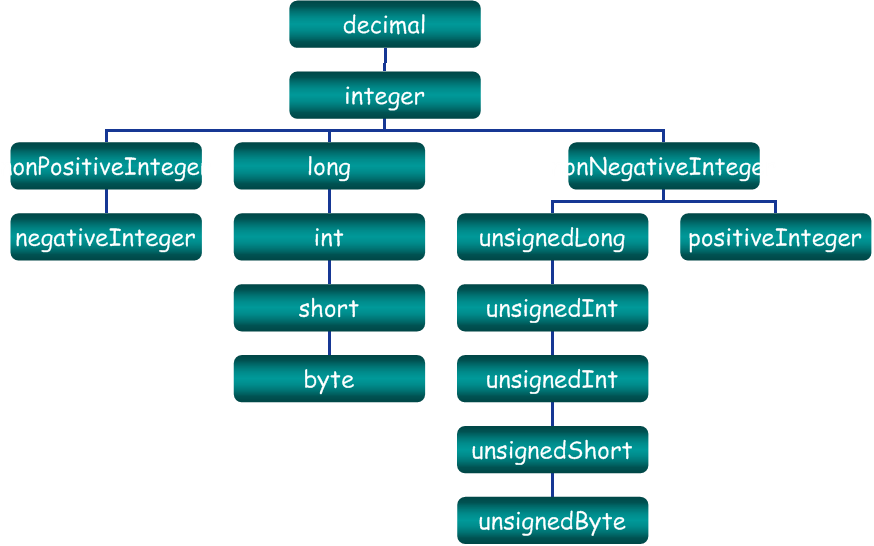XML_04_XML Schema
Posted
tags:
篇首语:本文由小常识网(cha138.com)小编为大家整理,主要介绍了XML_04_XML Schema相关的知识,希望对你有一定的参考价值。
DTD的不足
语法结构问题:与XML语法不一致,不支持DOM、XPath、XSLT等
数据类型问题:有限的数据类型,不支持布尔、日期、时间等数据,不能扩展
文档结构问题:DTD中元素和属性是全局的,不是上下文相关的
名称空间问题:不支持名称空间Schema的特点
Schema的优势
Schema是独立的XML文档,扩展名为.xsd
已经定义了丰富的数据类型,支持派生,支持格式约束
元素、属性具有上下文相关性
支持名称空间
Schema的不足
不能嵌入到XML文档中
语法较复杂
还不能定义属性和属性值的相关性,如若CPU的“厂商”为“Other”则必须在“描述”中声明
XML文档-》note.xml
- <?xml version="1.0" encoding="GB2312"?>
- <note xmlns:xsi="http://www.w3.org/2001/XMLSchema-instance"
- xsi:noNamespaceSchemaLocation="note.xsd">
- <to>Tove</to>
- <from>Jani</from>
- <heading>Reminder</heading>
- <body>Don‘t forget me Forever!</body>
- </note>
DTD文档-》note.dtd
- <?xml version="1.0" encoding="GB2312"?>
- <!ELEMENT note (to, from, heading, body)>
- <!ELEMENT to (#PCDATA)>
- <!ELEMENT from (#PCDATA)>
- <!ELEMENT heading (#PCDATA)>
- <!ELEMENT body (#PCDATA)>
schema文档-》note.xsd
- <?xml version="1.0" encoding="GB2312"?>
- <xs:schema xmlns:xs="http://www.w3.org/2001/XMLSchema" elementFormDefault="qualified" attributeFormDefault="unqualified">
- <xs:element name="note">
- <xs:complexType>
- <xs:sequence>
- <xs:element name="to" type="xs:string"/>
- <xs:element name="from" type="xs:string"/>
- <xs:element name="heading" type="xs:string"/>
- <xs:element name="body" type="xs:string"/>
- </xs:sequence>
- </xs:complexType>
- </xs:element>
- </xs:schema>
根元素schema
Schema文档的根元素schema的声明<?xml version="1.0" encoding="GB2312"?><xs:schema xmlns:xs="http://www.w3.org/2001/XMLSchema" elementFormDefault="qualified" attributeFormDefault="unqualified">Schema文档的根元素只能为schemaschema 中用到的元素和数据类型来自名称空间"http://www.w3.org/2001/XMLSchema”elementFormDefault和 attributeFormDefault分别为qualified(限定的)和unqualified(非限定的),表明元素名称需要给出名称空间,而 属性名不需要
名称空间的声明
Schema中对名称空间的声明:<xs:schema targetNamespace=“目标名称空间URL" xmlns:xs="http://www.w3.org/2001/XMLSchema" xmlns=“默认名称空间URL">targetNamespace(目标名称空间):是引用该Schema的XML文档的名称空间,即XML文 档中元素、属性、数据类型等名称的有限范围,对应的是一个URL,可以不是一个文件标准名称空间:即定义了Schema标准的名称空间,包括 schema、element、simpleType、string等关键字、内置数据类型和标准的Schema语法等默认名称空间:即省略了名称空间前 缀的名称所属的空间(可以与目标空间不同)
名称空间的引用
在XML文档中引用Schema的名称空间:其实这个特点的好处就是可以为特定的命名空间绑定特定的schema,一般情形使用前者即可,简单
若Schema文档中没有定义目标名称空间,则<元素名称 xmlns:xsi=“http://www.w3.org/2001/XMLSchema-instance” xsi:noNamespaceSchemaLocation=“Schema文档URI">若Schema文档中已定义了目标名称空间,则& lt;元素名称 xmlns=“默认空间URL" xmlns:xsi="http://www.w3.org/2001/XMLSchema-instance" xsi:schemaLocation="目标空间URL Schema文档URI">
例如- <!--Schema文档(文件名为score.xsd)-->
- <?xml version="1.0" encoding="gb2312"?>
- <xs:schema xmlns:xs="http://www.w3.org/2001/XMLSchema" xmlns=“http://127.0.0.1/xml” targetNamespace=“http://127.0.0.1/xml” elementFormDefault="qualified" attributeFormDefault="unqualified">
- <xs:element name="学生" type=“xs:string"/>
- </xs:schema>
- <!--XML文档-->
- <?xml version="1.0" encoding="GB2312"?>
- <学生 xmlns=http://127.0.0.1/xml xmlns:xsi="http://www.w3.org/2001/XMLSchema-instance” xsi:schemaLocation="http://127.0.0.1/xml score.xsd">张绍康</学生>
元素和属性的声明
在根元素schema下定义顶层子元素(top level element),在某元素内定义其子元素和属性
元素声明
<xs:element name=名称 type=类型/>
属性声明
<xs:attribute name=名称 type=类型 use=次数/>数据类型
Schema的数据类型分为简单类型、复杂类型两种
复杂类型complexType
复杂类型定义XML元素的结构关系,如包含属性、子元素、子元素间的关系等例如- <xs:complexType name="学生型">
- <xs:sequence>
- <xs:element name="姓名" type="xs:string"/>
- <xs:element name="年龄" type="xs:int" minOccurs="0"/>
- </xs:sequence>
- <xs:attribute name="学号" type="xs:int"/>
- </xs:complexType>
Schema中可定义“学生型”元素:
<xs:element name=“学生” type=“学生型”/>
只有元素的内容可以是复杂类型的
简单类型simpleType
简单类型的数据是XML最小的结构单位例如- <xs:simpleType name=“编号型”>
- <xs:restriction base=“xs:int”/>
- </xs:simpleType>
定义了“编号型”数据类型,其基础类型为整型,因此
<xs:attribute name=“编号” type=“编号型”/>
<xs:element name=“编号” type=“编号型”/>
所定义的属性、元素的内容都必须是整型
若元素是简单类型,则不能包含子元素。对于属性而言,由于属性值不允许再分割,因此只能是简单类型
数据类型派生(Derivation)
与面向对象方法中类的派生相似,XML Schema支持数据类型的派生,即在已经定义的数据类型基础上,定义新的数据类型。可以在简单类型基础上派生新的简单类型或复杂类型,也可以在复杂类型 基础上派生新的复杂类型。复杂类型的派生有扩展派生(extension)、约束派生(restriction)两种,简单类型的派生有扩展派生、约束派 生、列表派生(list)、联合体派生(union)四种。最常见的派生是复杂类型的扩展派生、约束派生和简单类型的约束派生例如- <xs:simpleType name=“邮政编码”>
- <xs:restriction base=“xs:string”>
- <xs:pattern value=“\d{6}”/>
- </xs:restriction>
- </xs:simpleType>
Schema的内部数据类型
Schema内置了许多数据类型,包括字符串、数值、逻辑、日期时间、URI等,其中大部分是简单类型。默认类型可以是anyType或anySimpleType。
只有部分内置的数据类型属于原始类型(Primitive),即不能通过取值约束方式从其他数据类型派生出来的数据类型,这些数据类型包括:
字符型:string、QName、NOTATION
数值型:float、double、decimal逻辑型:boolean
日期时间型:date、time、duration、eYear、……
URI型:anyURI二进制:base64Binary、hexBinary


复杂类型complexType
complexType定义复杂数据类型,声明元素的属性、子元素、文本内容等
复杂数据类型可以是具名的,也可以是匿名的
具名复杂类型(必须有name属性)只能定义在schema元素下,是全局的
匿名复杂类型(不能有name属性)只能出现在element元素下,是局部的若complexType的父元素是schema或redifine,就必须有一个simpleContent或complexContent子元素。
若父元素是element,则可以包含attribute、group等子元素。
complexContent
complexContent是complexType的子元素,表示该complexType将显式地从其他complexType派生。
complexContent必须有一个子元素extension或restriction来扩展或约束complexType的定义
simpleContensimpleContent用于从simpleType派生complexType,表示该complexType只有文本内容,没有子元素- <?xml version="1.0" encoding="GB2312"?>
- <xs:schema xmlns:xs="http://www.w3.org/2001/XMLSchema" elementFormDefault="qualified" attributeFormDefault="unqualified">
- <xs:element name="文件系统">
- <xs:complexType>
- <xs:complexContent>
- <xs:restriction base="目录类">
- <xs:sequence>
- <xs:element name="目录" type="目录类" minOccurs="0" maxOccurs="unbounded" />
- <xs:element name="文件" type="文件类" minOccurs="0" maxOccurs="unbounded" />
- </xs:sequence>
- <xs:attribute name="创建时间" type="xs:dateTime" use="prohibited"/>
- <!--不能出现在实例文档中 -->
- </xs:restriction>
- </xs:complexContent>
- </xs:complexType>
- </xs:element>
- <xs:complexType name="目录类" final="extension">
- <xs:complexContent>
- <xs:extension base="文件类">
- <xs:sequence>
- <xs:element name="目录" type="目录类" minOccurs="0"
- maxOccurs="unbounded" />
- <xs:element name="文件" type="文件类" minOccurs="0"
- maxOccurs="unbounded" />
- </xs:sequence>
- </xs:extension>
- </xs:complexContent>
- </xs:complexType>
- <xs:complexType name="文件类">
- <xs:attribute name="名称" type="文件名" use="required" />
- <xs:attribute name="创建时间" type="xs:dateTime" />
- </xs:complexType>
- <xs:simpleType name="文件名" final="#all">
- <xs:restriction base="xs:token">
- <xs:pattern value=‘[^|\\\*\?:"<>]+‘ />
- </xs:restriction>
- </xs:simpleType>
- </xs:schema>
简单类型simpleType
simpleType定义从Schema已定义的简单类型再派生的简单类型,简单类型不能再包含任何元素或属性简单数据类型也可以分为 具名的或匿名的具名简单类型有name属性,只能定义在schema元素下,是全局的匿名简单类型不能有name属性,可以出现在element、 attribute、list、restriction、union元素下,是局部的complexType必须有一个子元素,可以是list、 union或restriction之一
array.xsd:- <?xml version="1.0" encoding="GB2312"?>
- <xs:schema xmlns:xs="http://www.w3.org/2001/XMLSchema" elementFormDefault="qualified" attributeFormDefault="unqualified">
- <xs:element name="数组">
- <xs:complexType>
- <xs:attribute name="数组元素" type="整数列表" use="required"/>
- <xs:attribute name="容量" type="整数和无穷" use="required"/>
- </xs:complexType>
- </xs:element>
- <xs:simpleType name="整数列表">
- <xs:list itemType="整数和无穷"/>
- </xs:simpleType>
- <xs:simpleType name="整数和无穷">
- <xs:union memberTypes="xs:integer">
- <xs:simpleType>
- <xs:restriction base="xs:NMTOKEN">
- <xs:enumeration value="无穷"/>
- </xs:restriction>
- </xs:simpleType>
- </xs:union>
- </xs:simpleType>
- </xs:schema>
array.xml
- <?xml version="1.0" encoding="UTF-8"?>
- <数组 xmlns:xsi="http://www.w3.org/2001/XMLSchema-instance"
- xsi:noNamespaceSchemaLocation="array.xsd" 容量="3" 数组元素="1 -1 无穷">
- </数组>
扩展entension
- <xs:simpleType name="姓名">
- <xs:restriction base="xs:token">
- <xs:minLength value="2"/>
- </xs:restriction>
- </xs:simpleType>
- <xs:complexType name="人员">
- <xs:simpleContent>
- <xs:extension base="姓名">
- <xs:attribute name="性别" use="required"/>
- </xs:extension>
- </xs:simpleContent>
- </xs:complexType>
列表
list.xsdxml version="1.0" encoding="GB2312"?>- <xs:schema xmlns:xs="http://www.w3.org/2001/XMLSchema">
- <xs:element name="专家门诊">
- <xs:complexType>
- <xs:sequence>
- <xs:element name="专科" maxOccurs="unbounded">
- <xs:complexType>
- <xs:attribute name="名称" type="xs:token" use="required"/>
- <xs:attribute name="专家" type="姓名列表" use="required"/>
- </xs:complexType>
- </xs:element>
- </xs:sequence>
- </xs:complexType>
- </xs:element>
- <xs:simpleType name="姓名列表">
- <xs:list>
- <xs:simpleType>
- <xs:restriction base="xs:token">
- <xs:minLength value="2"/>
- </xs:restriction>
- </xs:simpleType>
- </xs:list>
- </xs:simpleType>
- </xs:schema>
- <?xml version="1.0" encoding="UTF-8"?>
- <专家门诊 xmlns:xsi="http://www.w3.org/2001/XMLSchema-instance"
- xsi:noNamespaceSchemaLocation="list.xsd">
- <专科 专家="张三 李四 王五" 名称="内科" />
- </专家门诊>
并union
- <xs:simpleType name="成绩">
- <xs:union>
- <xs:simpleType>
- <xs:restriction base="xs:NMTOKEN">
- <xs:enumeration value="优秀"/>
- <xs:enumeration value="良好"/>
- <xs:enumeration value="中"/>
- <xs:enumeration value="及格"/>
- <xs:enumeration value="不及格"/>
- </xs:restriction>
- </xs:simpleType>
- <xs:simpleType>
- <xs:restriction base="xs:int">
- <xs:minInclusive value="0"/>
- <xs:maxInclusive value="100"/>
- </xs:restriction>
- </xs:simpleType>
- </xs:union>
- </xs:simpleType>
- <xs:attribute name=“成绩” type=“成绩”/>
- <学生 name=“张三” 成绩=“95”/>
- <学生 name=“李四” 成绩=“及格”/>
选择choice······
数据取值
Schema的优势之一是允许对数据的取值进行综合设置,可以定义数据的取值范围、输入和显示方式,等等。
取值约束
对简单类型,可以采用取值约束限制数据的取值:
长度限制:length、maxLength、minLength
大小限制:maxExclusive、minExclusive、maxInclusive、minInclusive
精度限制:fractionDigits、totalDigits
模式匹配:pattern(正则表达式)
空白处理:whiteSpace
枚举类型:enumeration- <xs:simpleType name=“邮政编码”>
- <xs:restriction base=“xs:string”>
- <xs:pattern value=“[0-9]+” fixed=“1”/>
- <xs:length value=“6” fixed=“true”/>
- </xs:restriction>
- </xs:simpleType>
- <xs:simpleType name=“技术职称”>
- <xs:restriction base=“xs:string”>
- <xs:enumeration value=“教授”/>
- <xs:enumeration value=“副教授”/>
- <xs:enumeration value=“讲师”/>
- <xs:enumeration value=“助教”/>
- <xs:enumeration value=“无”/>
- </xs:restriction>
- </xs:simpleType>
键key和键引用
keyrefKey元素定义键约束,键的值由一个或多个字段组成,在实例文档中,对于包含键的的元素,键值必须是唯一的已定义的键可以被keyref元素 通过refer属性引用,以构成键引用约束在key元素中,从包含元素开始,用selector元素选出key的参考元素,在参考元素基础上,用 field元素选出键值
keyref.xsd- <?xml version="1.0" encoding="GB2312"?>
- <xs:schema xmlns:xs="http://www.w3.org/2001/XMLSchema">
- <xs:element name="学生名单">
- <xs:complexType>
- <xs:sequence>
- <xs:element name="班级" maxOccurs="unbounded">
- <xs:complexType>
- <xs:sequence>
- <xs:element name="学生" maxOccurs="unbounded">
- <xs:complexType>
以上是关于XML_04_XML Schema的主要内容,如果未能解决你的问题,请参考以下文章
项目一众筹网01_04环境搭建_表述层springMvc的搭建快速打开web.xml快捷键@RequestBody和@ResponseBody的区别以及好处